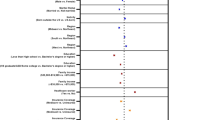Abstract
The Centers for Disease Control and Prevention recommends routine HIV screening in health care settings. Using national surveillance data, we assessed trends in HIV diagnoses and testing frequency in youth aged 13–24 diagnosed with HIV in 2005–2008. Diagnosis rates increased among black (17.0% per year), Hispanic (13.5%), and white males (8.8%), with increases driven by men who have sex with men (MSM). A higher percentage of white males and MSM had previously been tested than their counterparts. No increases in diagnoses or differences in testing were observed among females. Intensified interventions are needed to reduce HIV infections and racial/ethnic disparities.
Resumen
Los Centros para el Control y la Prevención de Enfermedades recomiendan que las pruebas de detección del VIH sean parte de la rutina del cuidado médico. Usando datos de vigilancia nacional, evaluamos la tendencia en los diagnósticos y la frecuencia de las pruebas del VIH en jóvenes entre las edades de 13–24 años diagnosticados con el VIH entre 2005 y 2008. La tasa de diagnóstico aumentó en los hombres afroamericanos (17.0% por año), Hispanos (13.5%), y blancos (8.8%), con incrementos principalmente en los hombres que tienen relaciones sexuales con hombres (HSH). Comparado con sus homólogos, un mayor porcentaje de hombres blancos y HSH se hicieron pruebas del VIH antes del diagnostico. No se observaron incrementos en los diagnósticos ni diferencias en las pruebas entre las mujeres. Es necesario intensificar las intervenciones para reducir las infecciones por el VIH y las disparidades raciales y étnicas.

Similar content being viewed by others
References
Centers for Disease Control and Prevention. Sexual and reproductive health of persons aged 10–24 years—United States, 2002–2007. Surveillance summaries, July 17, 2009. MMWR. 2009;58(SS-6).
Centers for Disease Control and Prevention. HIV/AIDS surveillance report, 2007. Vol. 19. Atlanta: U.S. Department of Health and Human Services, Centers for Disease Control and Prevention; 2009. http://www.cdc.gov/hiv/topics/surveillance/resources/reports/. Accessed March 31, 2010.
Hall HI, Byers RH, Ling Q, Espinoza L. Racial/ethnic disparities in HIV prevalence and disease progression among men who have sex with men. Am J Public Health. 2007;97(6):1060–6.
Centers for Disease Control and Prevention. HIV infection among young black men who have sex with men—Jackson, Mississippi, 2006–2008. MMWR. 2009;58:77–81.
Centers for Disease Control and Prevention. Revised Recommendations for HIV testing of adults, adolescents, and pregnant women in health-care settings. MMWR. 2006;55(RR-14):1–17.
Centers for Disease Control and Prevention. Youth risk behavior surveillance—United States, 2009. Surveillance summaries, June 4, 2010. MMWR. 2010;59:1–142.
Hightow LB, Leone PA, MacDonald DM, McCoy SI, Sampson LA, Kaplan AH. Men who have sex with men and women: a unique risk group for HIV transmission on North Carolina college campuses. Sex Transm Dis. 2006;33(10):585–93.
Wohl DA, Rosen D, Kaplan AH. HIV and incarceration: dual epidemics. AIDS Read. 2006;16(5):247–50, 257–60.
Keppel K, Pamuk E, Lynch et al. Methodological issues in measuring health disparities. National Center for Health Statistics. Vital Health Stat. 2005;2(141).
Millett GA, Flores SA, Peterson JL, Bakem R. Explaining disparities in HIV infection among black and white men who have sex with men: a meta-analysis of HIV risk behaviors. AIDS. 2007;21(15):2083–91.
Wheeler WH. Men who have sex with men and women among men with newly diagnosed HIV infections in the United States, 2001–2005. Report submitted to the Rollins School of Public Health in partial fulfillment for the degree of Master of Public Health. Emory University, 2007.
Centers for Disease Control and Prevention, HIV/AIDS Prevention Research Synthesis Project. 2009 Compendium of evidence-based HIV prevention interventions. Atlanta, GA: Centers for Disease Control and Prevention, December 2009, Revised. http://www.cdc.gov/hiv/topics/research/prs/evidence-based-interventions.htm.
Acknowledgements
The Centers for Disease Control and Prevention (CDC) funds all states and the District of Columbia to conduct HIV surveillance and selected areas to perform HIV incidence surveillance and provides technical assistance to all funded areas. All participating investigators and contributors are CDC employees or contractors.
Author information
Authors and Affiliations
Corresponding author
Additional information
The findings and conclusions in this study are those of the authors and do not necessarily represent the views of the Centers for Disease Control and Prevention.
Rights and permissions
About this article
Cite this article
Hall, H.I., Walker, F., Shah, D. et al. Trends in HIV Diagnoses and Testing Among U.S. Adolescents and Young Adults. AIDS Behav 16, 36–43 (2012). https://doi.org/10.1007/s10461-011-9944-8
Published:
Issue Date:
DOI: https://doi.org/10.1007/s10461-011-9944-8



